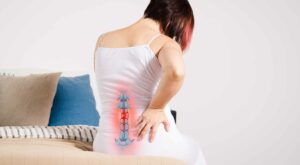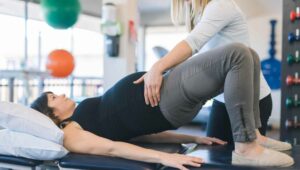A sudden twinge in your lower back when you stand up, a nagging ache after a long day at work, a sharp jolt of pain when you lift something heavy—does this sound familiar? You’re not alone. It’s a pervasive problem that many women across the globe experience lower back pain at various stages of their lives. But what causes this discomfort? Why is it that women, in particular, seem more susceptible to it?
In this post, we will delve into the depths of this common condition, exploring the various factors that contribute to lower back pain in women so that you can take necessary precautions, and seek the appropriate care when needed. So, let’s get started!
Contents
Decoding Lower Back Pain in Women
 Lower back pain can be an intensely frustrating and debilitating issue, especially when it becomes a chronic problem. It’s a condition that occurs when you feel discomfort in the area of the lumbar vertebrae, the five large bones in the lower part of the spine. This pain can range from a dull, constant ache to a sudden, sharp sensation that leaves you incapacitated.
Lower back pain can be an intensely frustrating and debilitating issue, especially when it becomes a chronic problem. It’s a condition that occurs when you feel discomfort in the area of the lumbar vertebrae, the five large bones in the lower part of the spine. This pain can range from a dull, constant ache to a sudden, sharp sensation that leaves you incapacitated.
For women, lower back pain can be particularly concerning. Women tend to have a lower center of gravity, wider hips, and differences in the lumbar curve compared to men, which can contribute to an increased incidence of lower back pain. Furthermore, factors unique to women – such as menstrual cycles, pregnancy, and specific female health conditions like endometriosis or fibroids – can also lead to or exacerbate lower back pain. Given its prevalence and potential impact on quality of life, understanding lower back pain in women is crucial.
The rest of the article will delve into specific causes, preventative measures, and treatment options, offering comprehensive guidance for those grappling with this condition.
Exploring the Causes of Lower Back Pain in Women
As we delve deeper into this topic, we’ll explore a range of causes, from hormonal changes to physical conditions, that specifically impact females. This knowledge will provide you with a comprehensive understanding, aiding in the prevention, management, and treatment of lower back pain. Now, let’s unfold these causes one by one.
Hormonal Changes and Menstruation
 A woman’s body goes through numerous hormonal changes during the menstrual cycle, and these can sometimes lead to lower back pain. The hormones prostaglandins, which trigger the uterus to contract during menstruation, can cause discomfort and pain in the lower back area. This is usually temporary and subsides after the menstrual period. Understanding this correlation can help in managing and reducing such cyclical lower back pain.
A woman’s body goes through numerous hormonal changes during the menstrual cycle, and these can sometimes lead to lower back pain. The hormones prostaglandins, which trigger the uterus to contract during menstruation, can cause discomfort and pain in the lower back area. This is usually temporary and subsides after the menstrual period. Understanding this correlation can help in managing and reducing such cyclical lower back pain.
Pregnancy-Related Back Pain
 Pregnancy often brings about a host of changes in a woman’s body, and one common side effect is lower back pain. As the baby grows, a mother’s center of gravity shifts forward, often leading to changes in posture and increased stress on the lower back. Additionally, weight gain during pregnancy can put extra pressure on the spine. Hormonal changes, particularly an increase in the hormone relaxin, which makes ligaments in the body more flexible in preparation for childbirth, can also contribute to back discomfort. Understanding these changes can help expectant mothers seek appropriate relief and treatment options.
Pregnancy often brings about a host of changes in a woman’s body, and one common side effect is lower back pain. As the baby grows, a mother’s center of gravity shifts forward, often leading to changes in posture and increased stress on the lower back. Additionally, weight gain during pregnancy can put extra pressure on the spine. Hormonal changes, particularly an increase in the hormone relaxin, which makes ligaments in the body more flexible in preparation for childbirth, can also contribute to back discomfort. Understanding these changes can help expectant mothers seek appropriate relief and treatment options.
Lifestyle Factors Contributing to Lower Back Pain in Women
Several lifestyle factors can contribute to lower back pain in females. Here are a few noteworthy ones:
- Sedentary Behavior: Long periods of inactivity can weaken the muscles that support the spine, leading to back pain. This is especially true for individuals who sit for extended periods with poor posture.
- Carrying Heavy Bags: Regularly carrying heavy bags, especially on one shoulder, can put uneven pressure on the spine, resulting in lower back pain over time.
- Wearing High Heels: High heels can shift your center of gravity and strain the lower back. Wearing them frequently can lead to or exacerbate back discomfort.
- Obesity: Excess weight puts extra pressure on the spine and can contribute to lower back pain. Regular exercise and a balanced diet can help maintain a healthy weight and reduce the risk of back pain.
Recognizing these factors can be the first step towards making lifestyle adjustments to relieve and prevent lower back pain.
Endometriosis and Lower Back Pain
 Endometriosis is a condition that affects many women worldwide. It occurs when tissue similar to the lining of the uterus grows outside of the uterine cavity. This can cause pain in various parts of the body, and the lower back is no exception.
Endometriosis is a condition that affects many women worldwide. It occurs when tissue similar to the lining of the uterus grows outside of the uterine cavity. This can cause pain in various parts of the body, and the lower back is no exception.
The pain from endometriosis can be persistent and might intensify during menstrual periods. It’s important to know that endometriosis-related pain can often be mistaken for typical menstrual cramps or lower back pain. If your lower back pain is chronic and intensifies during your period, it might be a sign of endometriosis.
Remember, only a healthcare professional can diagnose endometriosis. If you suspect that you might be dealing with this condition, don’t hesitate to consult a medical expert. They can help you understand your symptoms better and provide the appropriate treatment options.
Osteoporosis and Back Pain
Osteoporosis, a bone disease characterized by low bone mass and deterioration of bone tissue, is significantly more common in women, especially post-menopausal women. This condition can lead to an increased risk of fractures, often causing back pain or even leading to a change in posture.
When osteoporosis affects the vertebrae or the bones of the spine, it can lead to a condition known as a compression fracture. These fractures can be extremely painful and can result in lower back pain. In some cases, these fractures can occur with minimal stress, such as bending over or lifting a light object.
It’s crucial for women, especially as they age, to be aware of the risk of osteoporosis. Regular exercise, a balanced diet rich in calcium and vitamin D, and regular medical check-ups can help maintain bone health and potentially prevent this condition. If you’re experiencing persistent lower back pain, it’s worth discussing osteoporosis with your healthcare provider.
Preventing Lower Back Pain: Tips for Women

Preventing lower back pain in females isn’t just about avoiding heavy lifting or treating it once it happens. It involves making conscious lifestyle changes and incorporating habits that promote back health into your everyday routine. Here are some practical tips that can help reduce the risk of lower back pain:
- Maintain a Healthy Weight: Extra pounds, especially in your midsection, can make back pain worse by shifting your center of gravity and putting strain on your lower back.
- Strengthen Your Core: Strong core muscles are important to provide support for the lower back and avoid injury. Low-impact cardiovascular exercises and weight training can be beneficial, as can specific exercises that target the abdomen and back muscles.
- Be Conscious of Your Posture: Poor posture can put pressure on your back and cause pain. When standing, keep your weight balanced on your feet. Sit on an exercise ball or chair with good lower back support.
- Lift Properly: When lifting and carrying heavy objects, lift with your legs and not your back. Hold the object close to your body and do not twist when lifting.
- Quit Smoking: Smoking impairs blood flow, resulting in oxygen and nutrient deprivation to spinal tissues.
- Manage Stress: Stress can cause muscle tension, leading to back pain. Techniques such as yoga, meditation, or deep breathing can help manage stress levels.
Remember, while these tips can help prevent back pain, they’re not a substitute for medical advice. If you’re experiencing lower back pain, it’s important to seek professional help to identify and address the underlying cause.
When to Consult a Healthcare Provider
Experiencing occasional lower back pain after strenuous physical activity is normal. However, when the pain persists, intensifies over time, or is associated with other alarming symptoms, it’s crucial to seek professional healthcare advice. Here are some situations when you should definitely consult a healthcare provider:
- Persistent Pain: If your pain is consistent, worsening, and lasts for more than a few weeks, it’s time to visit a healthcare provider. Persistent pain often indicates an underlying condition that needs to be addressed.
- Severe Pain: Severe pain that doesn’t improve with rest or over-the-counter pain medications requires medical attention. It may be a sign of a more serious health issue.
- Pain After an Injury: If your lower back pain has started or worsened after a fall, accident, or injury, seek immediate medical advice.
- Associated Symptoms: If your back pain is accompanied by fever, unexplained weight loss, bladder or bowel issues, or numbness and weakness in your legs, these could indicate a serious condition.
During the visit, your healthcare provider will conduct a comprehensive evaluation. This includes discussing your medical history, current symptoms, performing a physical examination, and potentially, running diagnostic tests. This process helps the provider reach a correct diagnosis and formulate a treatment plan best suited to your needs.
Treatment Options For Lower Back Pain in Females
 Effective treatment for lower back pain varies greatly depending on the underlying cause, the severity of the pain, and the individual’s overall health. Here are some of the typical treatment options that healthcare providers may suggest for managing lower back pain in females:
Effective treatment for lower back pain varies greatly depending on the underlying cause, the severity of the pain, and the individual’s overall health. Here are some of the typical treatment options that healthcare providers may suggest for managing lower back pain in females:
- Physical Therapy: This is often the first-line treatment for lower back pain. A physical therapist can provide targeted exercises that strengthen the back and core muscles, improving flexibility and reducing pain.
- Pain Management: Over-the-counter pain relievers, non-steroidal anti-inflammatory drugs (NSAIDs), and muscle relaxants can help manage acute lower back pain. In some cases, prescription medications may be necessary.
- Lifestyle Modifications: Changes in lifestyle, such as maintaining a healthy weight, regular physical activity, proper posture, and a balanced diet can significantly help in managing and preventing lower back pain.
- Alternative Therapies: Techniques such as massage, acupuncture, yoga, and chiropractic treatments have proven beneficial for some women dealing with lower back pain.
- Surgical Options: In severe cases or when conservative treatments fail to provide relief, surgical procedures might be considered. The type of surgery will depend on the specific cause of the pain, such as a herniated disc or spinal stenosis.
Conclusion
Lower back pain can significantly impact a woman’s quality of life, but it’s important to remember that you’re not alone in this struggle. Understanding the possible causes, recognizing the symptoms, and knowing when to seek professional help are all critical steps toward finding relief. Above all, don’t hesitate to reach out to professionals who can help guide you on your journey toward better back health.
Remember, if you’re experiencing Back pain, physical therapy for back pain at PhysioMantra can help: Book an online physical therapy session.



